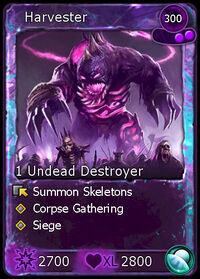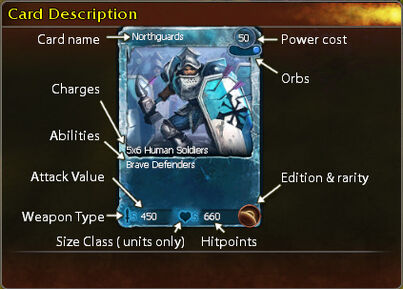(Fixed links) |
(Fixed navbox) |
||
| Line 83: | Line 83: | ||
==See Also == |
==See Also == |
||
*[[Deck|Card Deck]] |
*[[Deck|Card Deck]] |
||
| + | {{Navbox|Gameplay}} |
||
| − | |||
| − | {{Gameplay Navigation}} |
||
[[Category:Game Mechanics]] |
[[Category:Game Mechanics]] |
||
Revision as of 01:34, 8 May 2009

For card listings, see Card Categories.
BattleForge cards contain the primary information for a BattleForge unit, building, or spell. BattleForge cards are virtual and digital, in that there no physical cards are planned for production; the "cards" are stored on EA's BattleForge servers, yet they can be traded and auctioned in-game. With the exception of monuments, power wells and walls, everything players can create or cast are defined by the BattleForge cards.
Card Reading

A BattleForge card indicating Name, Power Cost, Orb Cost, Charge, Class, Special Abilities, Damage, Life, Edition, and Rarity
Each BattleForge card contains vital information to playing that card as well the card's edition and rarity. The following sections describe the parts of the card.
Card Name
The name of the card is found at the top-left of the card and is preceeded by the upgrade level, if upgraded.
Power Cost
The power is shown at the top-right and indicates power required to cast the card. Power costs of cards typically range from 25 to 300 for the most powerful creations.
Orb Requirements
The number of orbs and elements required to cast the card and is displayed below the power cost. Orbs are obtained by creating monuments. Solid-filled orbs indicate that one or more orbs with a specific element are required, while open orbs can be filled by a monolith of any element.
Card Artwork
The artwork is an artist's concept of the card's creation or effect and takes up the majority of the card's area.
Card Class
At the bottom-left corner of the artwork, the card's type is indicated. Unit cards indicate the unit's race and class, building cards indicate the class of building, and spells indicate the spell's class.
Unit Classes The unit class generally indicates the unit's role in combat and its capabilities. The following are typical classes for most units:
- Soldier - Essential melee combatant, balanced damage and life
- Archer - Ranged combatant, higher damage, lower life
- Wizard - Spell-casting combatant, very high damage, very low life
- Supporter - Supportive role, varies
- Dominator - Combatant amongst the strongest for its tier, higher damage and life, but higher casting cost
- Destroyer - Powerful combatant with siege capabilities
- Corruptor - Similar to wizard, though usually upgraded and often has flying capability
Building Classes The building class indicates the building's role in the game:
- Tower - Building with attack capabilities
- Shrine - Support structure, no attack capabilities
- Hut - Support structure, no attack capabilities
- Device - Support structure, no attack capabilities
- Fortress - Strongest buildings, often with attack capability
Spell Classes There are two spell classes as of the first edition of cards:
Card Charges
The maximum number of times that a card can be cast within a match before the card gets cooldown. After spending all charges the cooldown has to finish before this card gets one charge again and you can play it once before it is on cooldown again. The cooldown varies from card to card, generally the more Orbs a card needs, the longer it will take until you can use that card again(min. about 5 seconds up to a max of 3 minutes).
Special Abilities
See main article: Special Abilities.
If a unit has special abilities, they're shown directly below card class. A few units have no special abilities and will have a very short description instead. Special abilities are preceeded by different icons to indicate how the ability is activated.
Card Damage
(Only shown for units and buildings that have a basic attack, such as towers and some fortresses) Shows the amount of damage inflicted by the basic attack the unit or buillding. If the card is a unit, the damage is preceeded by two icons, one representing the type of attack and the other representing the size of unit against which the card is most effective: S, M, L, or XL. Alternatively, both icons may be replaced by a "star" indicating that the attack is special. Special attacks are not especially effective against any particular unit size. Effective attacks do 50% extra damage against the enemy.
Card Life
(Only shown for units and buildings) Shows the maximum amount of life for the unit or building. If the card is a unit card, the life is preceeded by the size of the creature: S, M, L, or XL.
Card Edition and Rarities
The final bits of information on a card are its edition and rarity, displayed by an icon in the bottom-right hand corner of the card. The edition is indicated by a set of themed icons for a particular edition of cards. At thus time, the only available edition is Twilight. The rarity of the card indicates the relative availability and probability of obtaining the card in booster packs. There are four levels of rarity:
- Common
Availability: 5-in-8 cards - Uncommon
Availability: 1-in-4 cards - Rare
Availability: 5-in-48 cards - Ultra-Rare
Availability: 1-in-48 cards
Card Upgrades
See main article: Upgrades
BattleForge cards support an upgrade mechanism which allows players to increase the power of their favorite cards. Upgrades are performed in the Card Upgrades window, which can only be accessed from the Forge UI (upgrades cannot be performed while playing a match). The card upgrades window can be opened from Inventory and right-clicking a card or upgrade card and clicking Upgrade.
Cards can be upgraded two levels, with each level having two types of upgrades, regular upgrades and charge upgrades. Regular upgrades are either won from PvE loot or claimed using PvP Tokens via the claim upgrade tab in the card upgrade window. Regular upgrades have one or more of the following effects:
- Increase power of special abilities
- Give a new special ability
- Increase damage
- Increase life
Regular upgrades cards also specify the upgrade level, I or II. the To upgrade a card to a level 1, an upgrade card for the card and level (e.g. Eruption I) and gold are needed. Likewise, to upgrade a card to level 2, both upgrade cards for the card (e.g. Eruption I and Eruption II) and gold are needed. If you have the necessary upgrades, the upgrade card is shown in the window and the checkbox by the upgrade will light up. Clicking the checkbox will update the preview card below the original as well as show the gold Upgrade Cost at the bottom of the window. Clicking combine will perform the upgrade if you have the requisite amount of gold. Once an upgrade is applied to a card, the card can no longer be traded (according to section 3.19 of the FAQ [1]).
Upgraded units are indicated by one or two ticks above the unit's healthbar.
Charge upgrades allow the user to increase the number of charges for a card, thus allowing the player to cast the card more times within a match. Unlike regular upgrades, charge upgrades do not require a special upgrade card and require a duplicate of the card instead. Thus to perform the first charge upgrade, Upgrade I and a duplicate card are required. No additional gold is required, however the duplicate card is consumed.
See Also
Battleforge has been revived by a group of passionate players and developers under the name Skylords Reborn
It is a fully functional, community-made, non-profit and completely free-to-play relaunch of the game. The relaunch has been worked on for several years, and receives regular updates.
The new Wiki can be found here: Skylords Reborn Wiki Page
.
